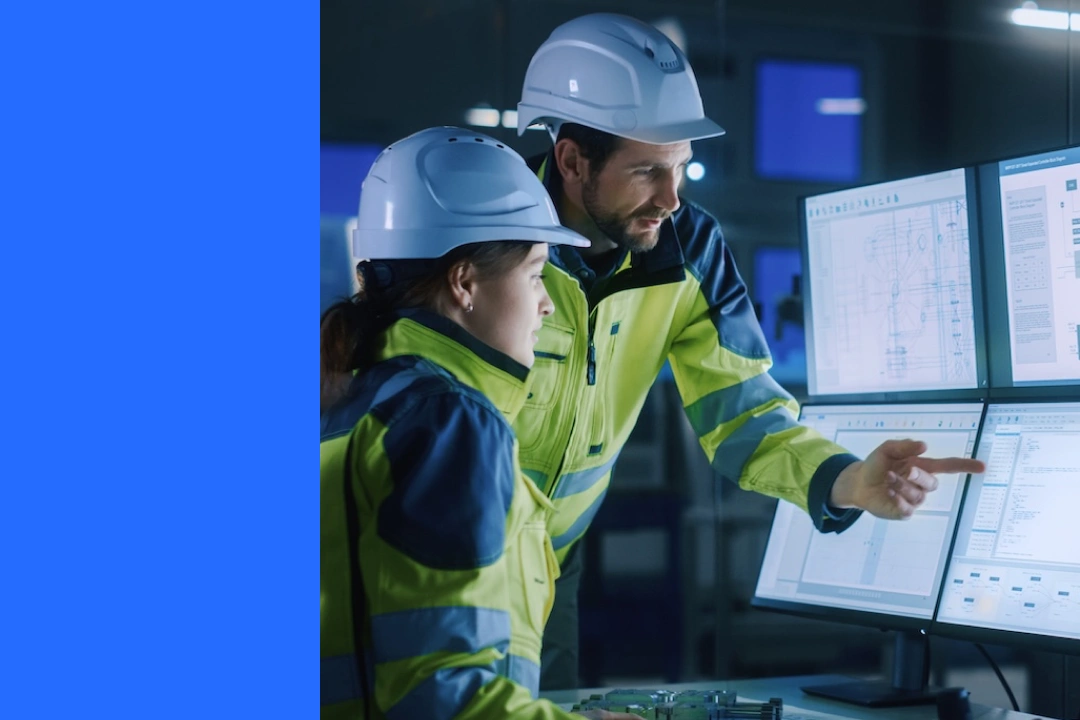
Imagine walking through a bustling hotel kitchen, a hospital ward mid-shift change, or a factory floor humming with machinery. Now, imagine what happens when a task gets botched in these high-pressure environments because someone thought they knew how to do it.
At best, it's frustrating and slows everyone down. At worst, it turns into an expensive or even dangerous mistake.
Clear, accessible, and detailed work instructions prevent unnecessary errors. Whether it’s a maintenance checklist or a step-by-step guide, work instructions help your team get tasks done right and on time.
In this guide, we look at the characteristics of good work instructions and how to write them.
Key takeaways
- Work instructions provide guidance on how to perform specific tasks and ensure accuracy, safety, and consistency across teams.
- SOPs and work instructions are different concepts. SOPs explain what needs to be done and why, while work instructions focus on how to do it.
- Key elements of good work instructions include an easily scannable format, simple language, and visuals.
What are work instructions?
Work instructions (also called job aids, work guides, or user manuals) are documented guidelines that clarify how to perform assignments.
They provide your team with a precise description of the steps required to perform a task. The goal is to minimize setbacks, damages, and inconveniences.
Various industries rely heavily on work instructions, including manufacturing, healthcare, science and research, hospitality, and transport.
The difference between work instructions and SOPs
Managers often confuse work instructions with standard operating procedures (SOPs). Though both documents exist to communicate business procedures, they’re not the same.
SOPs outline the steps involved in completing a task from start to finish. On the other hand, work instructions describe how workers should perform individual SOP steps. In other words, work instructions explain how to execute SOPs.
Here’s an example:
- SOP: “Steel Frame Assembly SOP” outlines the process for assembling structural steel frames, including safety checks, tooling requirements, and sequence of operations.
- Work instruction: “How to assemble a steel base frame for a conveyor unit” is a work instruction referenced within the “Steel Frame Assembly SOP.” It provides step-by-step assembly instructions, including specific measurements, torque settings, welding points, and inspection criteria.
Does every SOP need accompanying work instructions? No, you only need them for process steps that require more than a couple of sentences. Lengthy clarifications can clutter SOP checklists, cause confusion, and result in workers missing essential steps.
The easiest way to begin documenting a procedure is to outline the SOP steps first. Then, once the SOP is complete, go back and write work instructions for items that require greater clarification. This order ensures no gaps in understanding occur.
Why work instructions matter
Work instructions offer several benefits, such as:
- Reduced errors: Work instructions eliminate guesswork. They clearly outline each step to minimize the risk of errors that can lead to rework, downtime, or even injury.
- Faster training: New hires don’t have to shadow someone for weeks when they have detailed instructions. Work instructions give employees a clear, repeatable reference for completing tasks correctly from day one.
- Safer work environments: The risk of injury and accidents drops significantly when workers follow standardized steps, especially when operating machinery, handling hazardous chemicals, or sanitizing spaces. This ensures worker safety and saves companies from penalties that can reach over $160,000.
- Regulatory compliance: Documented work instructions help ensure workers perform tasks according to required standards. This makes audits less painful and compliance more reliable.

6 traits of good work instructions
The most important part of writing a work instruction? Leave nothing open to misinterpretation. Vague work instructions confuse employees, disrupt productivity, and often result in costly errors.
Here are six characteristics to aim for when developing work instructions:
Clarity
Good work instructions provide clear, precise, and comprehensive directions on how employees should perform tasks. Clarity means any employee can read a task description and understand its meaning immediately upon reading it. To ensure comprehension, avoid using acronyms, multi-syllable words, and unexplained technical terms.
Brevity
French mathematician and philosopher Blaise Pascal infamously said, “I have made this [letter] longer than usual because I have not had time to make it shorter.” If you’ve ever struggled to explain a complex topic succinctly, you understand Pascal’s struggle. Strive to thoroughly understand the tasks you’re writing about so you can describe them in a few words. Brevity equals simplicity.
Accessibility
Ensure employees have easy access to work instructions wherever they are, on-site and off-site. Fail to make the documents accessible, and some employees won’t bother tracking them down. Digital task-management systems like MaintainX allow workers to access SOPs, work instructions, and work orders from their mobile devices.
Consistency
Ensure work instructions are consistent with assigned employee skill sets. Additionally, they need to use the same methodology, terminology, and layout throughout the draft. Essentially, follow an SOP for developing work instructions. Errors are less likely to occur when employees know what to expect from organizational documents.
Accuracy
Ensure that work instructions are accurate, helpful, and credible. Managers should consult more experienced employees to ensure they aren’t missing important details. Only people who consistently complete a task know the ins and outs of how to do it.
Visual
Employees often find visual instructions easier to follow than multi-page manuscripts. Try incorporating infographics, images, and photos into your work instructions whenever possible.
How to write work instructions
The responsibility of creating work instructions should never lie with a single person. The best-written instructions include the input of several stakeholders. Here’s a step-by-step guide to writing good work instructions:
Step 1: Title the task clearly
First, write the document’s title. The title should refer to the task at hand. For example, “How to Disinfect Countertops” may be the title of work instructions explaining a restaurant’s opening procedures.
Step 2: Add a short introduction (why + who)
Write a brief introduction that:
- Provides contextual background
- Identifies task owners
- Describes the task’s purpose
This step will help you develop the document with a clear goal in mind.
With our previous example, the purpose of disinfecting restaurant countertops is to maintain a safe environment for patrons and to follow OSHA requirements.
Step 3: Outline task instructions in sequence
This step is self-explanatory: Describe how workers should complete the task. For example, the instructions for the task titled “How to Disinfect Countertops” may include:
- An explanation of how to disinfect the countertops in clear, detailed language
- A list of approved materials needed for the job
- Relevant references, including images, flowcharts, and tables, to enhance employee understanding
Step 4: Use consistent visual formatting
Here are some best practices to follow when formatting:
- Select a design format to use consistently throughout the document.
- Break down any necessary steps into numbered sequences, with each step representing a single action.
- If you’re using infographics, don’t just drop them onto the page. Refer to the images within the text for additional clarification.
- Ideally, keep images on the left and text on the right to avoid clutter.
- Use bold, italicized, and UPPER-CASE text to emphasize important pieces of information.
Step 5: Edit for clarity and brevity
Once you’re finished writing, review your draft. Eliminate extraneous words and simplify complex sentences to improve readability. Here are some quick editorial tips:
- Abbreviate correctly: Spell out complex terms on first use and enclose abbreviations in parentheses next to the initial term. Subsequently, you may use the abbreviation throughout the document. For example, refer to the first time I wrote the term standard operating procedures (SOPs) in this article.
- Provide a glossary: If you find yourself heavily referencing abbreviations, consider linking to a glossary of terminology.
- Maintain consistency: For example, if you use the term “liquid detergent” in one step, continue to use that term throughout the entire document to avoid confusion.
Affordable editing software like Grammarly or Hemingway helps with editing to improve readability and remove grammatical errors. You can also ask ChatGPT to point out grammatical errors in your text.
Step 6: Link to resources and glossary
Look for opportunities to provide additional resources and reading materials. You can do this either by adding footnotes or including an appendix at the end of the work instruction document.
Step 7: Test and revise based on feedback
Test the process instructions before you make them available company-wide:
- Ask an employee or colleague to follow the directions and perform the associated task. This exercise will reveal any instructional gaps that need clarification.
- Observe and take note of how your colleague performs the job so you can go back and improve the document.
- Once you’ve confirmed the instructions are easy to understand and follow, begin including them within associated SOPs and work orders.
- Review the effectiveness of instructions regularly and strive for continuous improvement.
Example work instruction format
Make work instructions accessible with a CMMS
Work instructions make your team’s job easier, provided your team can readily access them at all times.
A mobile-friendly computerized maintenance management system (CMMS) like MaintainX gives your team real-time access to work instructions for all business processes.
If you’re ready to organize your SOPs and work instructions, check out our guide on how to successfully implement a CMMS.
FAQs
What is the purpose of work instructions?
The purpose of work instructions is to provide clear, step-by-step instructions on how to perform a task correctly and safely. They help ensure consistency, reduce errors, and help new or temporary workers complete tasks without constant supervision.
Are work instructions the same as SOPs?
No, work instructions and SOPs aren’t the same. SOPs outline what needs to be done and why at a high level. Work instructions explain how to do each specific task in detail. Think of SOPs as the recipe and work instructions as the steps in the cooking process.
Who should write work instructions?
Someone who understands the task should write the work instructions, typically a supervisor, experienced technician, or process engineer. Ideally, they collaborate with frontline workers to ensure instructions are accurate, practical, and easy to follow.
What format is best for work instructions?
The best format for work instructions depends on the task. In general, clear, step-by-step text instructions with visuals work best. Tables, bullet points, and numbered lists make information easy to scan, while photos, diagrams, and videos improve clarity and retention. Digital platforms like CMMS and quality management systems typically include built-in formats optimized for clarity.









